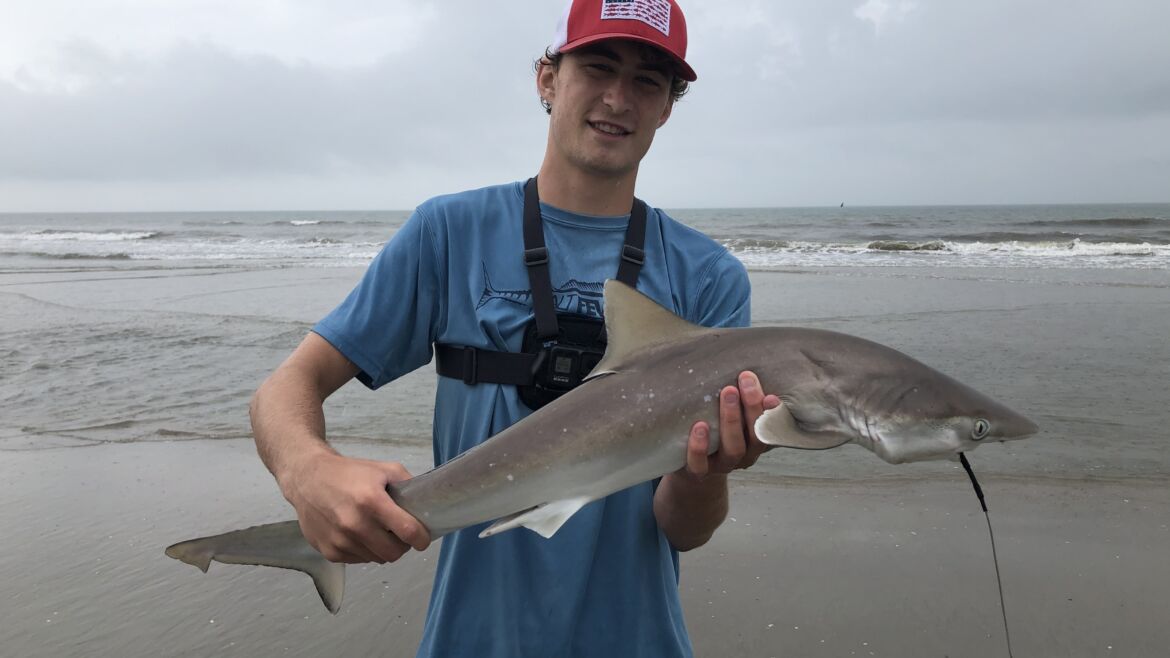Believe it or not, Shark fishing, specifically land-based Shark fishing, has taken the world by storm. With more access than ever to heavy-duty fishing equipment, anglers across the United States have taken up the challenge and raced to the beaches to catch their very own giant Sharks. Interestingly enough, we’re seeing a significant shift in how people view Sharks as a whole due to this method of fishing.
For many anglers including myself, catching Sharks in a boat can be painstaking, annoying, and even dangerous. Now obviously there are some who target Sharks from the boat and have methods of doing this very safely and effectively. But for the vast majority of saltwater anglers targeting other game fish, a Shark is simply bycatch. This is especially true while fishing offshore with dead or live bait. Sharks will often get in leaders and tear up your tackle. However, while Sharks from the boat can be annoying, land-based Shark fishing is a world of difference. No boats, few other lines, nothing to get snagged on, and you’re on your home turf (the land) which gives you far more leverage in a fight against such a large animal.

When I tell you there is nothing more exhilarating than being strapped to a Shark—I mean it—it’s genuinely like being hooked up to a freight train. If you had asked me about this kind of fishing 4 years ago, I would’ve said you were crazy, but having experienced this for myself, I want to share the joys of this relatively new type of fishing. So, sit back, relax, and listen up because what I’m about to tell you could genuinely change your view of Shark fishing or further improve what you already have going for you.
Choosing the Right Baits for Land-Based Shark Fishing
First order of business—bait. This, as well as the water condition, is probably the single most important factor that will play into whether or not you catch a Shark from the beach or not. Now I know from my past articles, that I generally break down this section into live and dead bait, but here, it’s not necessary. There are very few land-based Shark fishermen I know of that use live bait. It would be too much going on and extremely hard to actually keep your bait in the same position given the fact your bait is likely to be fairly big and strong. I do plan to experiment with live Shark bait this Summer, but for the sake of this article let’s focus on dead bait.
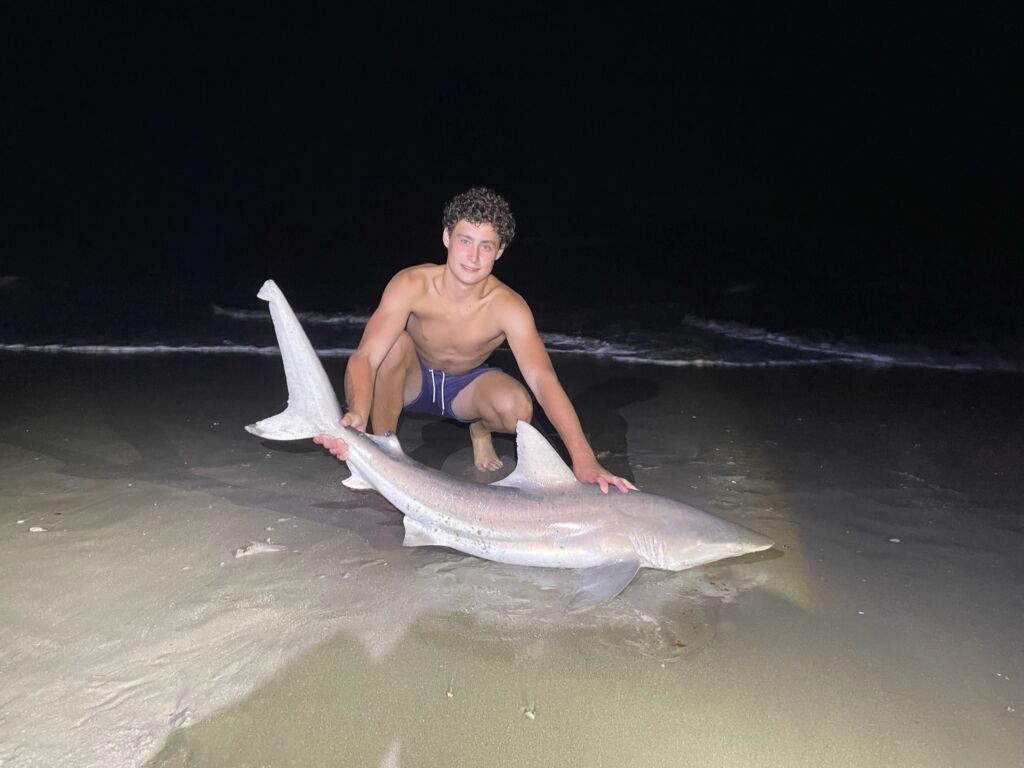
Below, I’m going to list some baits and then give some details that will make picking baits a bit easier.
- Small Baits (Finger Mullet/Pogy/Menhaden/other minnows): Unfortunately, for the Sharks we’re targeting in this article (3+ feet) that’s not gonna cut it. Now I’m not gonna say it’s impossible, but the Sharks are generally looking for something that sticks out a little more. Plus, the bigger issue is that small fish, especially bluefish, will torch any smaller bait you put out making it impossible to get to a Shark.
- Medium Baits (Bluefish/Spanish Mackerel/Big Mullet/Ladyfish): Now this is where things start getting interesting. First, I’ll start by saying that you’re still at risk of getting picked off by smaller fish. Additionally, I generally don’t use these baits to target Sharks larger than 5 feet. However, when I do fish these baits, I generally use pretty big chunks of fish, maybe only getting 2 or 3 baits from one Mackerel for example. Moreover, the ideal bait is the head of the fish and then about 3 inches of body behind it for extra meat. These baits can be killer and given the right time of year provide constant action on the beach. The last thing I will say is out of these baits listed, I’m picking Spanish Mackerel every single time without any hesitation. For whatever reason, Sharks love them—probably because they are oily fish. The best part about Spanish is that they are also plentiful and fairly easy to catch. There are days when my brother and I will go out and catch 30 just to freeze for Shark bait on later dates. This being said, plan and be picky with your baits.
- Fish Heads/Carcasses: This is where we start getting into the bigger baits. Now you can use almost any fish head as long as it has a little bit of meat on it. From personal experience, bonier heads are harder to use for two reasons. One, because it is far harder to get a hook through the skull and two because there’s not a lot of meat for the Shark to get at. For this reason, I tend to avoid Snapper heads because they tend to be very bony. Now obviously, if all you have is Snapper heads, then by all means use them, but if you have other choices, I would take those instead. Some of the fish heads preferred by a lot of Shark anglers are Grouper, Cobia, King Mackerel, and Jack heads. These all give a pretty good deal of meat while still having enough bone to stay on the hook. The only issue is that when using a fish head, some of the meat is exposed leaving you vulnerable to getting picked at by other small species like Bluefish or even crabs.
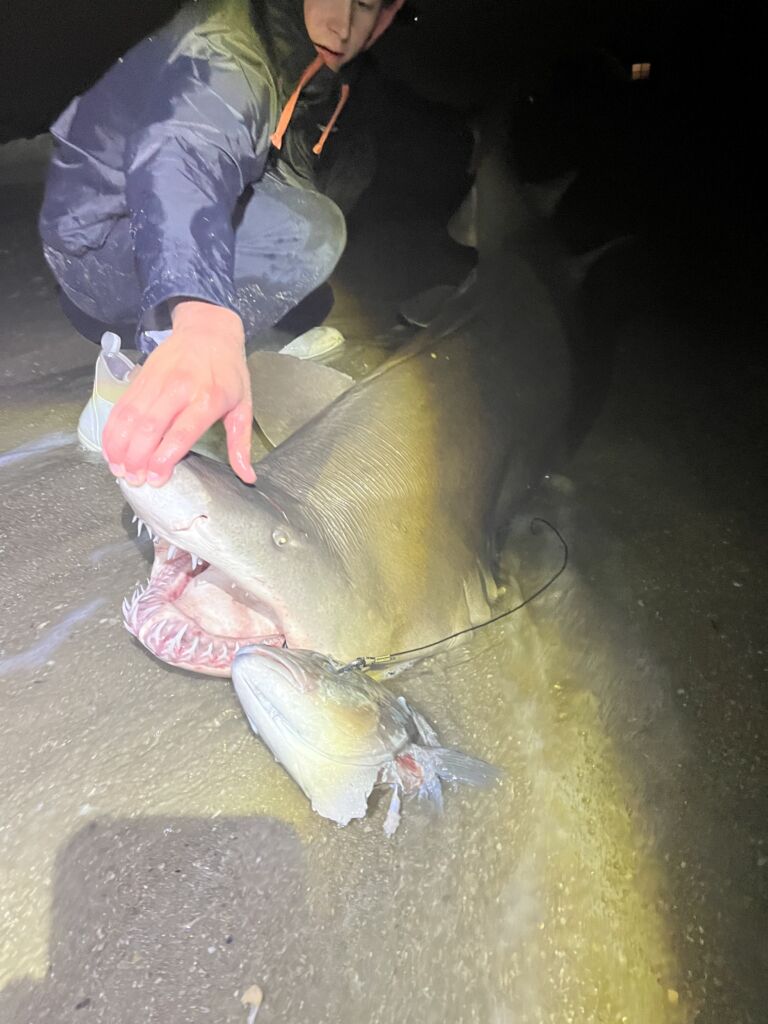
- Small Sharks: Now I know this doesn’t seem like it would be good Shark bait at all, but believe it or not, tons of Shark fishermen swear by using dead smaller Sharks for bait. 2–4-foot Sand Sharks are generally the preferred species. While these baits definitely are going to yield fewer bites than say a fish carcass, the class of Sharks that can attack these baits is far bigger than anything else we would normally encounter using other baits listed here. Only the biggest and worst of the Sharks can manage to take down one of these suckers. I get it, you probably think this is a stupid idea, but just give it a chance. Look at some videos online. Sharks eat these baits—and they eat them a whole lot more than you think. Lastly, there is one more advantage to using a small Shark for bait—nothing else will touch it. I can almost guarantee you will never have a bycatch because nothing other than a Shark is going to poke at your bait.
- Stingrays: By far and away the best possible bait for big Sharks. Not only does Stingray deter other species that can normally pick apart other baits, but they also have an unparalleled ability to draw Sharks. All of my big Sharks, aside from one, were caught using cut Stingray. For a reason I don’t know, Sharks love Stingray—perhaps because it is some of their natural prey. Anyways, if you have time and the resources to do so, it is well worth going out of your way to get Stingray for bait. I’m infinitely more confident with a Stingray on my hook than with any other bait that money could possibly buy.
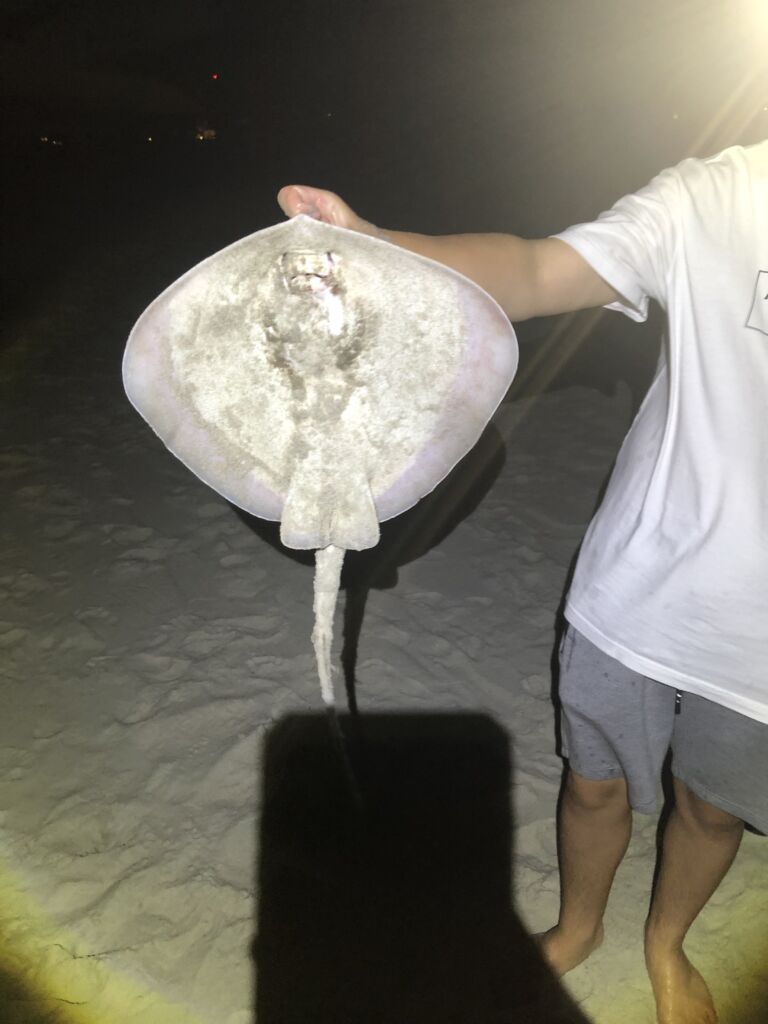
I hope this brief discussion of bait gives you a starting point on where to look and how to start your approach to catching Sharks. While bait is extremely important, you can also further boost the chances of success by paying attention to the conditions of the weather and biting in your area. Conveniently enough, the Fishbox App provides this much-needed information to the angler so take advantage and download the fishing app today.
Get your personalized fishing map
Answer a quick quiz and get your own personalized fishing map
Tactics for Land-Based Shark Fishing
Rigs:
Now different anglers will tell you different things regarding rigs for Sharks, but the main premise is that you should be using a bottom rig. As always, there still could be opposition to this because I know someone uses a float rig, but for the most part, Shark anglers are using bottom rigs. As a result, I’m going to break this down into two main rigs: one smaller rig for a cast-out rod and another heavy-duty rig for a kayak or drone deployment rig.
First for the smaller rig. I use a 12/0 or 14/0 circle hook which is then double barrel crimped to about 3 feet of 480-pound vinyl-coated wire. This is then crimped to a swivel which is crimped again to about 5 feet of 400-pound monofilament. On this monofilament, slide a snap swivel attached to a 4–6-ounce Sputnik weight. Then finally, crimp another swivel to the top of your rig and attach this swivel to your main line and you’re all good.
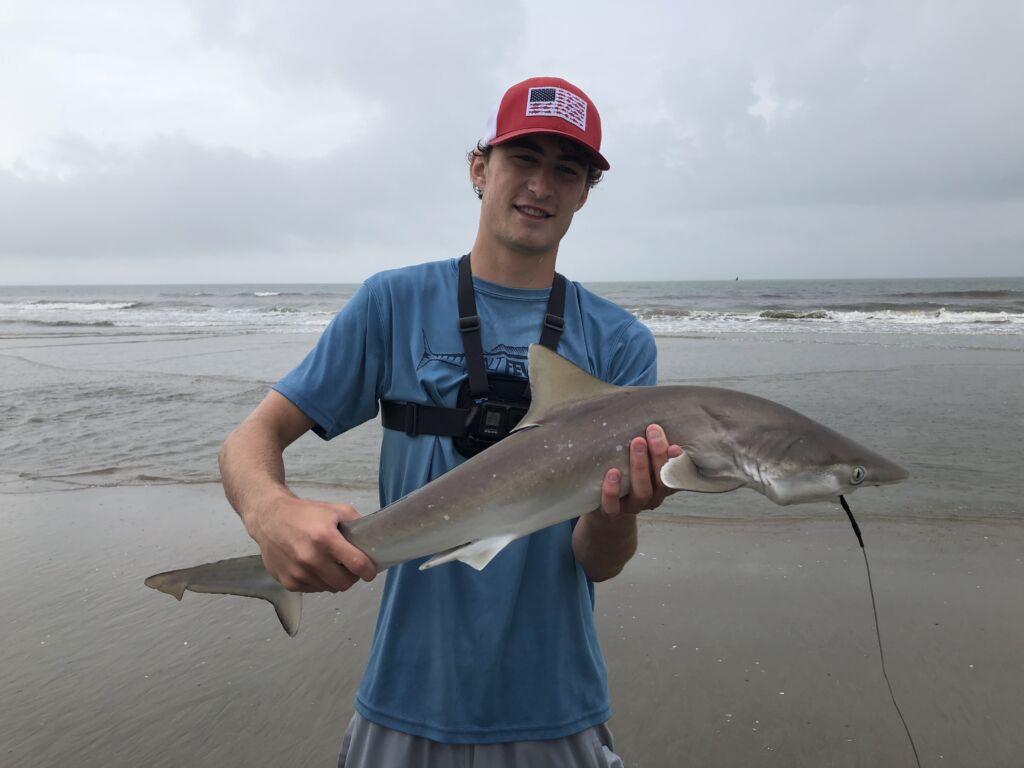
Now for the heavy-duty rig. I use a 20/0 circle hook which is crimped to 5 feet of 480-pound vinyl-coated wire. This is then crimped to a swivel which is then crimped to 15 feet of 400-pound monofilament. I slide the snap swivel onto the monofilament which is attached to a large spider weight (between 1 and 2 pounds) and then the rig is finished by crimping another swivel to the end of the monofilament. This swivel is then attached to your main line.
For the sake of making things easier for our readers, I’m going to link all my supplies at the bottom of the article so that you can make your rigs.
Gear:
Once again, fishing is a very subjective sport. Everybody is going to have a different way of doing something and that applies just the same to Shark fishing. For the sake of this article, I’m going to share the simple (but rather expensive) two-rod spread I normally use.
First, let’s start with the smaller rod. I use a 10-foot Ugly Stik Bigwater Surf Rod with a size 7500 Penn Spinfisher VI. On this reel, I have about 400 yards of 65-pound braid. The total cost of this combo is about $400 – $500.
Now for the big boy. I have a 6-foot Okiaya Black Venom Stand-Up rod rated at 80 to 130 pounds. For my reel, I have an Avet 50/2 EXW spooled with 800 yards of 100-pound hollow core braid spliced to 200 yards of 100-pound monofilament as my top shot.
The total cost of this combo is around $1300 – $1500.
I don’t say these numbers to brag or to scare you off, rather, I’m telling you this so you have a better idea of what your newfound addiction will run you. Before I close out this section, there are a few more things that you might need to tackle land-based Shark fishing.
Here’s a quick list:
- Bolt cutters (to cut the hook if you can’t pull it out).
- Crimpers (to make your rigs).
- Wire cutters (to make your rig).
- LED bulbs to illuminate your rods while fishing at night.
- Dehooker (to remove the hook from the Shark’s mouth).
- Rope (to wrap around Shark’s tail to pull it in).
- Headlamps (for night fishing).
- Rubber mallet (for rod spikes and hooking bait).
- Rod spikes (to hold your rod).
- Rubber bands (to wrap around your hook so the bait stays on).
- Harness/fighting belt (to keep the rod from getting ripped out of your hand).
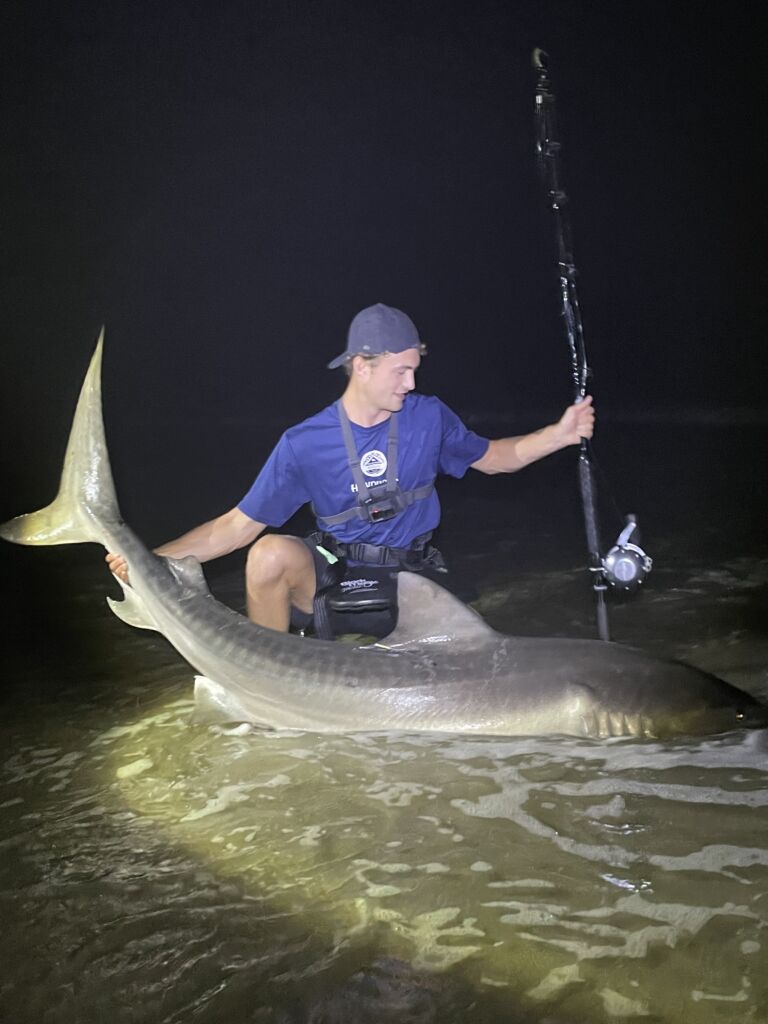
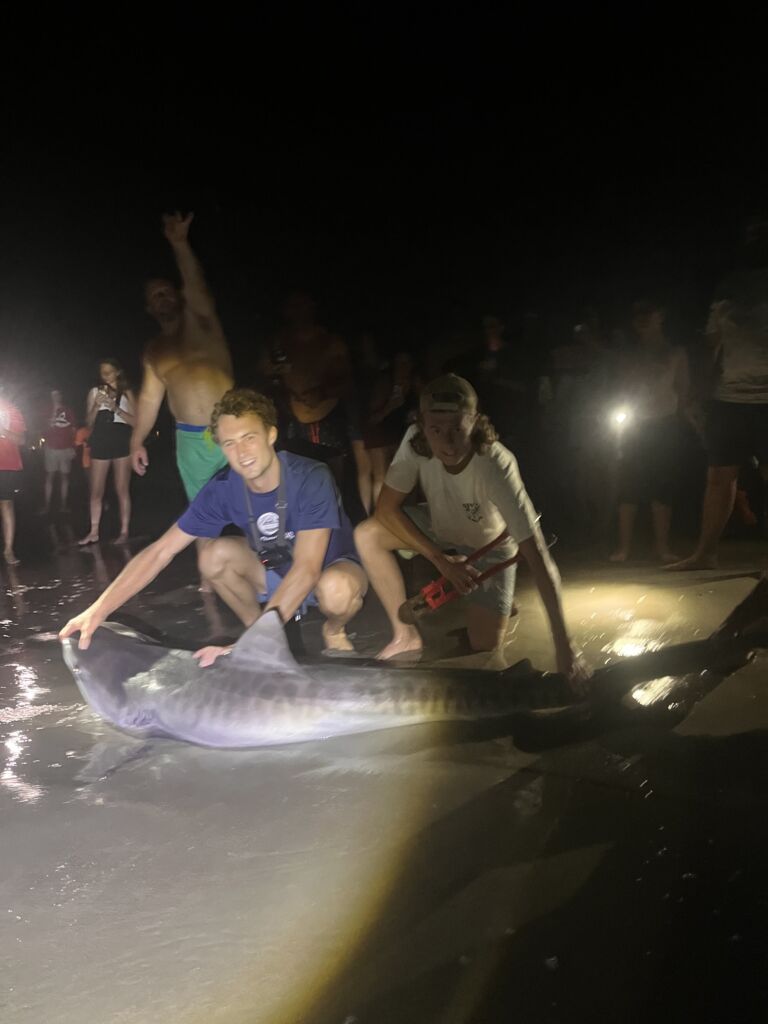
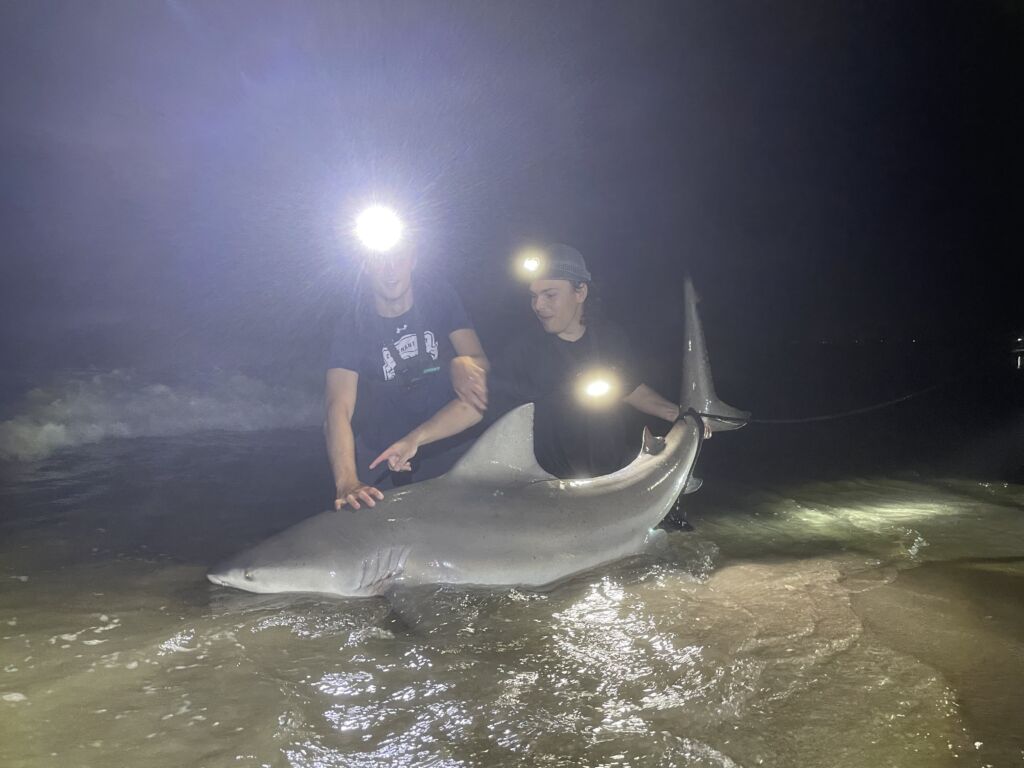
Spreads/Distance:
Before we move on to the next section of topics, I do want to give a little advice regarding your spreads. Again, it will vary from angler to angler, but for the most part, you want to cover a good variety of depth and distance from the beach anywhere between 50 and 600 yards depending on where you are doing the Shark fishing from. When I’m fishing, I’ll normally put my Spinfisher combo out about 75 to 100 yards and my Avet combo anywhere between 300 and 600 yards. From my research, most little Sharks are coming within 100 yards and the bigger Sharks (6+ feet) are coming from over 350 yards. Again, try different depths and record your findings so you can hone in on your fishery.
Beach Shark Fishing: Best Locations, Conditions, and Time of Year
Time of year:
While Sharks are around coastal areas and beaches all year long, there are definitely peak seasons in which bites and better fishing are far more likely. In addition to the information in this article, the Fishbox App can also help you with identifying some of these bite metrics so give it a spin and download the app today.
Get your personalized fishing map
Answer a quick quiz and get your own personalized fishing map
Just as a general rule of thumb, Shark fishing is going to be good going into late Spring and continuing to heat up until the hottest point in Summer when the water is hottest. The bite begins to fade with dropping water temperature but still stays relatively strong until about the middle or end of October. However, to make this easier, I have a list of some of the most popular Sharks and their preferred water temperatures.
- Sand Tiger Shark (54-20 degrees F).
- Sand Shark (60-70 degrees F).
- Dusky Shark (66-82 degrees F).
- Bull Shark (68+ degrees F).
- Tiger Shark (72+ degrees F).
- Lemon Shark (72-84 degrees F).
- Hammerhead Shark (68+ degrees F).
- Black Tip Shark (70-80 degrees F).
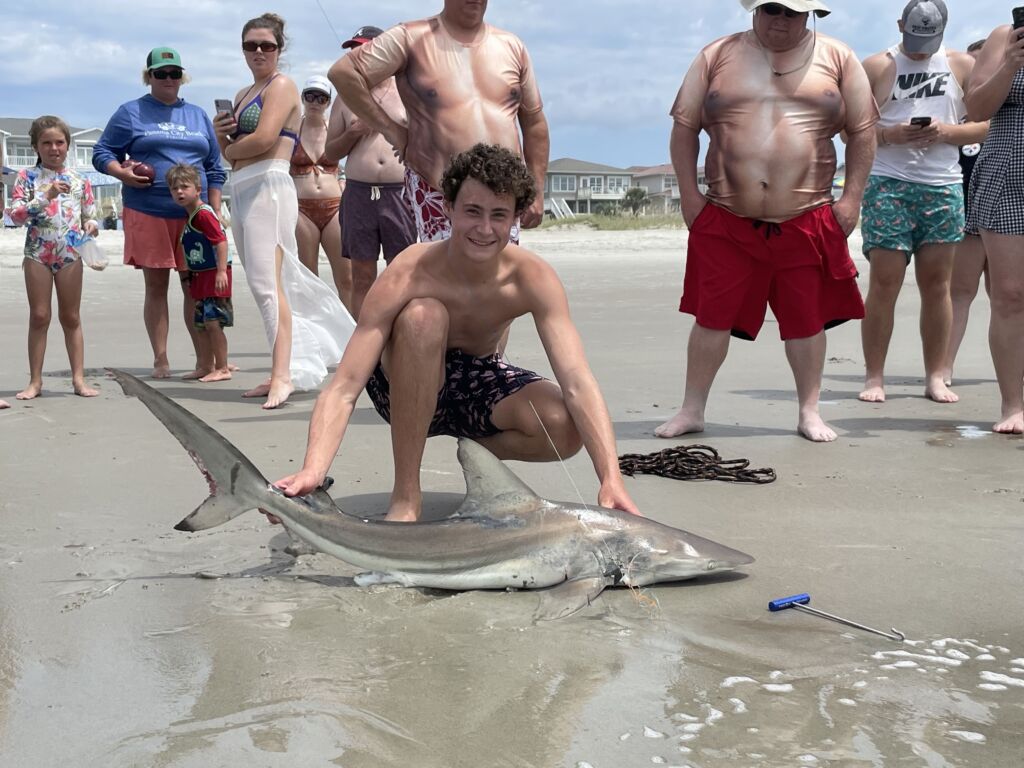
Water depth:
Water depth doesn’t matter all that much. As a general rule of thumb, the closer you are to the beach, the smaller the Sharks you’re going to catch. However, this is not always the case as with most things in fishing. Last year we put a chunk of Stingray about 50 yards out and it was smoked by an 8-foot Tiger Shark. The bigger Sharks do need a little more depth to work generally which is why I almost always set my big rod 300+ yards off the beach.
Weather:
This is where you’re going to figure out whether or not you should be Shark fishing today. Also, an important note, please Shark fish at night unless you are all alone on the beach. Trust me, I know it’s cool to us, but to the mom with her 3 kids in the water on the 4th of July—it’s not. Be a considerate person and make sure no one will be put in danger by your gear.
Plus, I know multiple people who have been Shark fishing during the day and got hooked to a passing boat only to lose $200 in tackle. Please be safe and smart with your hard-earned money.
Anyways, back to the weather. You need to remember that your bait has to be able to sit in the water relatively well and it can’t be bouncing all over the place. Even with a 2-pound spider weight, seas of 3+ feet will make it hard to deploy your bait or even get it to stay down or in the same spot.
From my own experience and research, weather doesn’t have too much of an effect on the Shark bite at all. If you get a bad storm that throws off the water, then you might be in a bit of trouble, but a quick rainstorm from the night before shouldn’t do anything.
Wind is another issue just because it makes the waves and can put your lines all over the place. Shark fishing is a lot of work, so pick a night where you will be able to enjoy it most and have a better chance at hooking a Shark. However, if the conditions are dicey, fish at your own risk. The sharks are most certainly still there—check out this picture of a Sand Tiger Shark we caught in 4-foot seas blowing 25 mph.
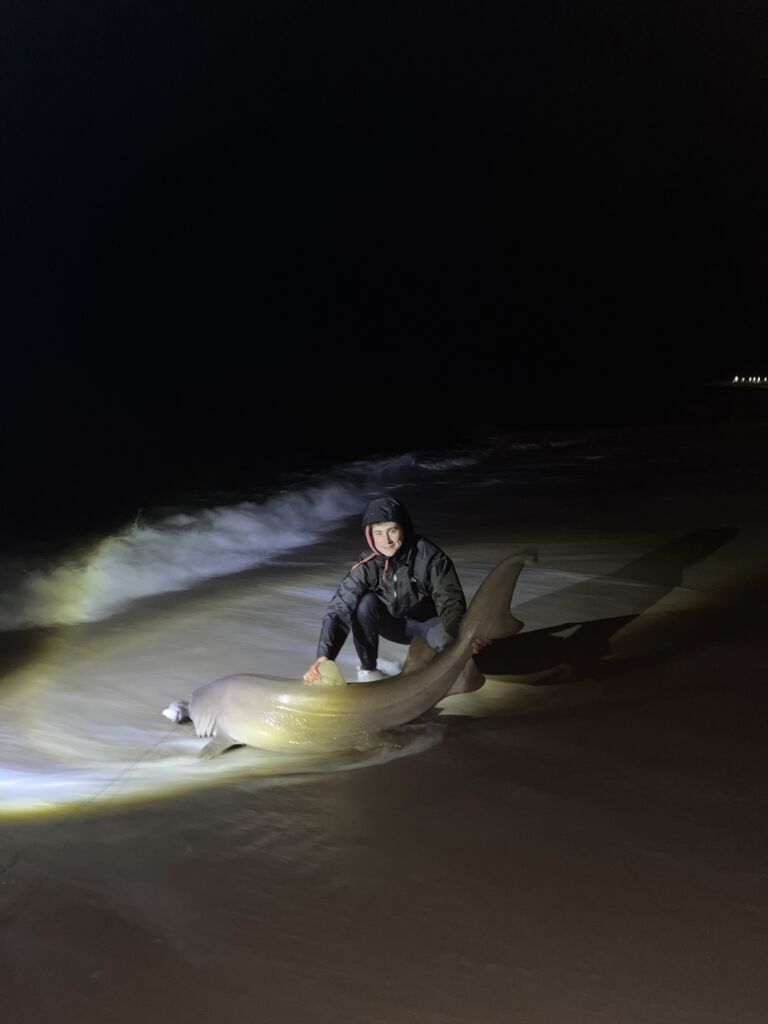
Structure:
Structure is something you shouldn’t have to worry about. However, if you are fishing a spot with a known structure, try to avoid it to the best of your ability. I would hate for you to lose a bunch of money in fishing tackle to a dumb snag.
Sharks are patrolling fish, so given enough time they will find your bait if they are hungry. You don’t need to go to a specific spot to catch them. One more thing, don’t be that guy that sets up right beside the pier, please. Yes, there are probably more Sharks in that area but there are also a lot of other people who are trying to fish as well. Fishing too close to the pier will ultimately end up in lines snagged, people angry and you may lose some gear—don’t be that guy.
A Typical Day for Land-Based Shark Fishing
Sunsets are fairly late at the beach during the Summer, but I try to have all of my gear out on the beach by 6:00 pm that way I have time to set up. Assuming we have a good night of weather, I will identify an open spot on the beach and set my gear down. I hammer in my rod spikes where I want them and then fill up a bucket with water to begin thawing the bait.
While the bait is thawing, I will tie on my rigs with improved clinch knots and then attach the weights. By this time, the bait should be mostly thawed so I hook it. First, I take my Spanish Mackerel head and hook it under the mouth and out the top of the head. For my big rod, I cut half of a 1-foot-wide Stingray and hook it through the body using rubber bands to make sure the hook doesn’t fall out. I then ordered my brother to kayak out the big rod about 400 yards straight out. Once he gets back from deploying the bait, I cast out the Spanish Mackerel head as far as I can (or if I’m feeling a little bold, I’ll have my brother kayak it out past the breakers).
Read also: Spanish Mackerel Fishing: Tips and Tricks to Catch More and Bigger Spanish Mackerel
Then begins the waiting game. Sit back in your beach chairs and enjoy some good conversation with your friends you invited to the beach with you.
2 hours later, your drag starts ripping on the big rod and you have a bite. You quickly put on the harness and reel into the hook set. 20 minutes later the Shark is close enough for your boys to put a tail rope on. You drag it up the beach a tad, but enough that water can still wash over it and get in the Shark’s gills. You take your measurements and pictures, get the dehooker or bolt cutters if the dehooker doesn’t work, and free the Shark off the hook. As quickly as you can, you drag the Shark back into the water by the tail and revive him for a little bit. You then push him off once you know he’s strong enough and make sure he goes on his strength. And there you go; you just caught your first big Shark.

Gear Links:
- All rig material.
- Ugly Stik Bigwater Surf Rod.
- Penn Spinfisher VI.
- Okiaya Black Venom Stand-Up Rod.
- Avet 50/2 EXW.
Conclusion:
I hope you have greatly enjoyed reading this article about land-based Shark fishing. It has become an addiction for me, and I hope that one day you guys will be able to experience it for yourselves. As always, if you have any questions, please let me know and I will get back to you immediately. Enjoy our God’s beautiful creation and respect it as well. As always, good luck and tight lines!
Photo Source: All photos in this article were provided by expert Pierce Latta.
Visit his Instagram profile.
Subscribe to his YouTube channel.
